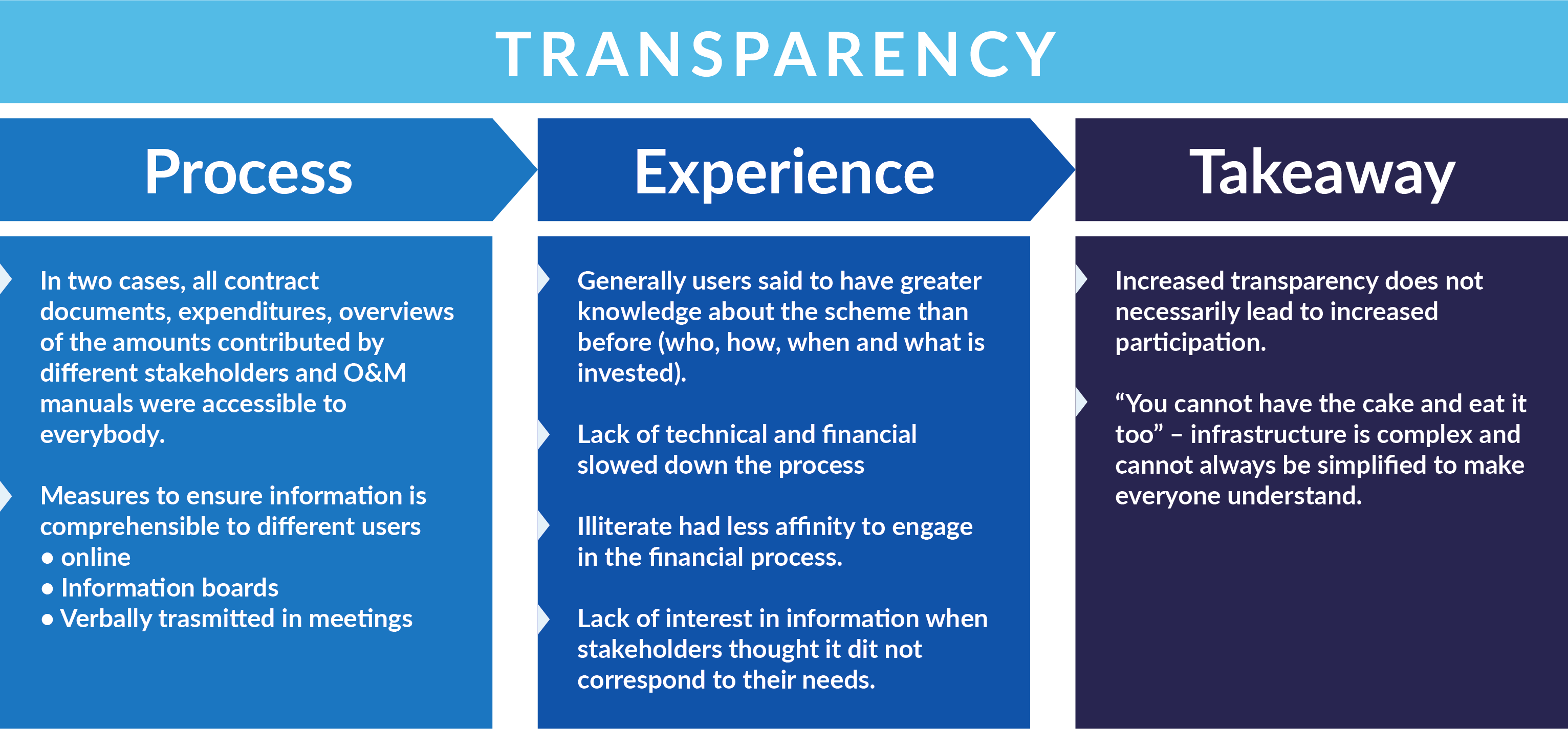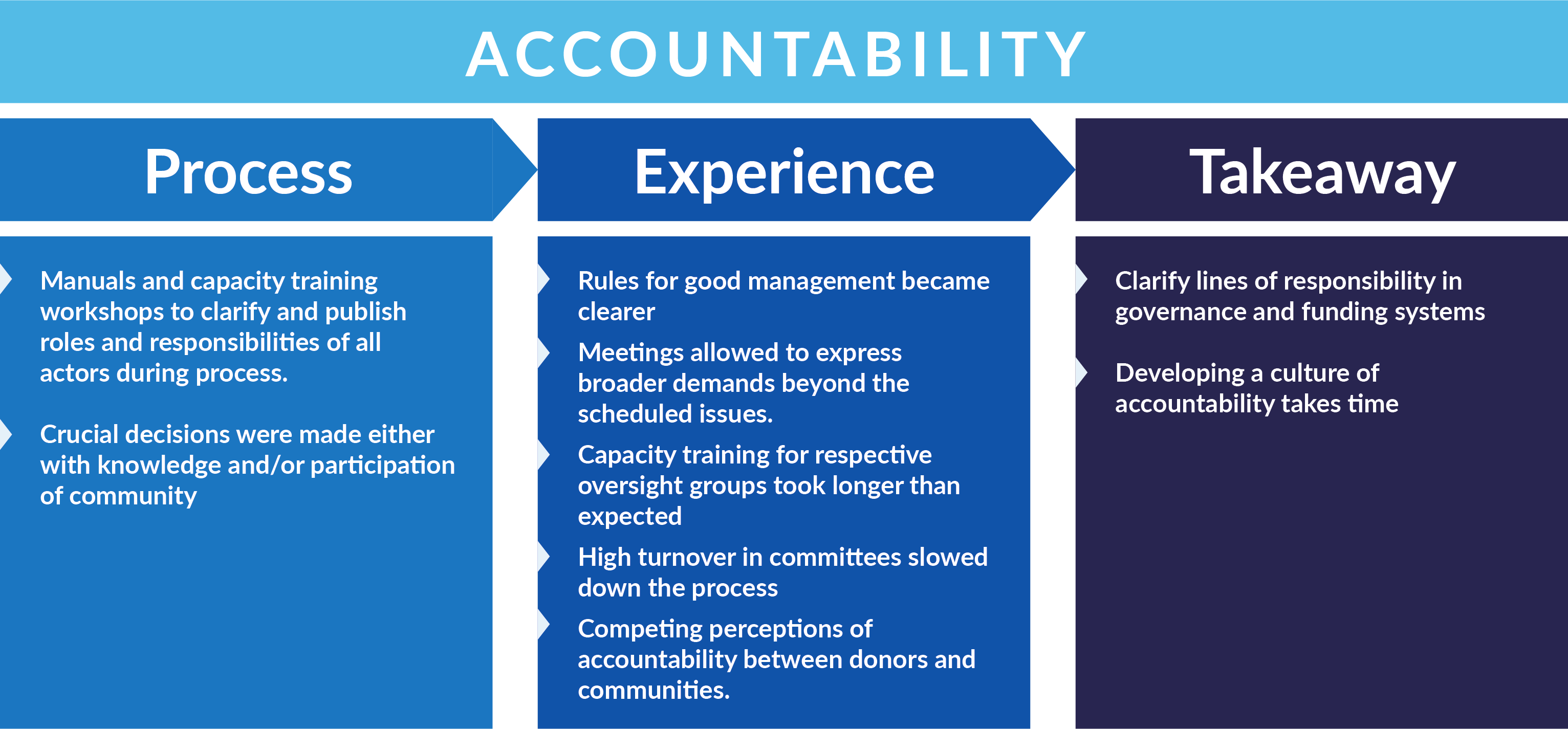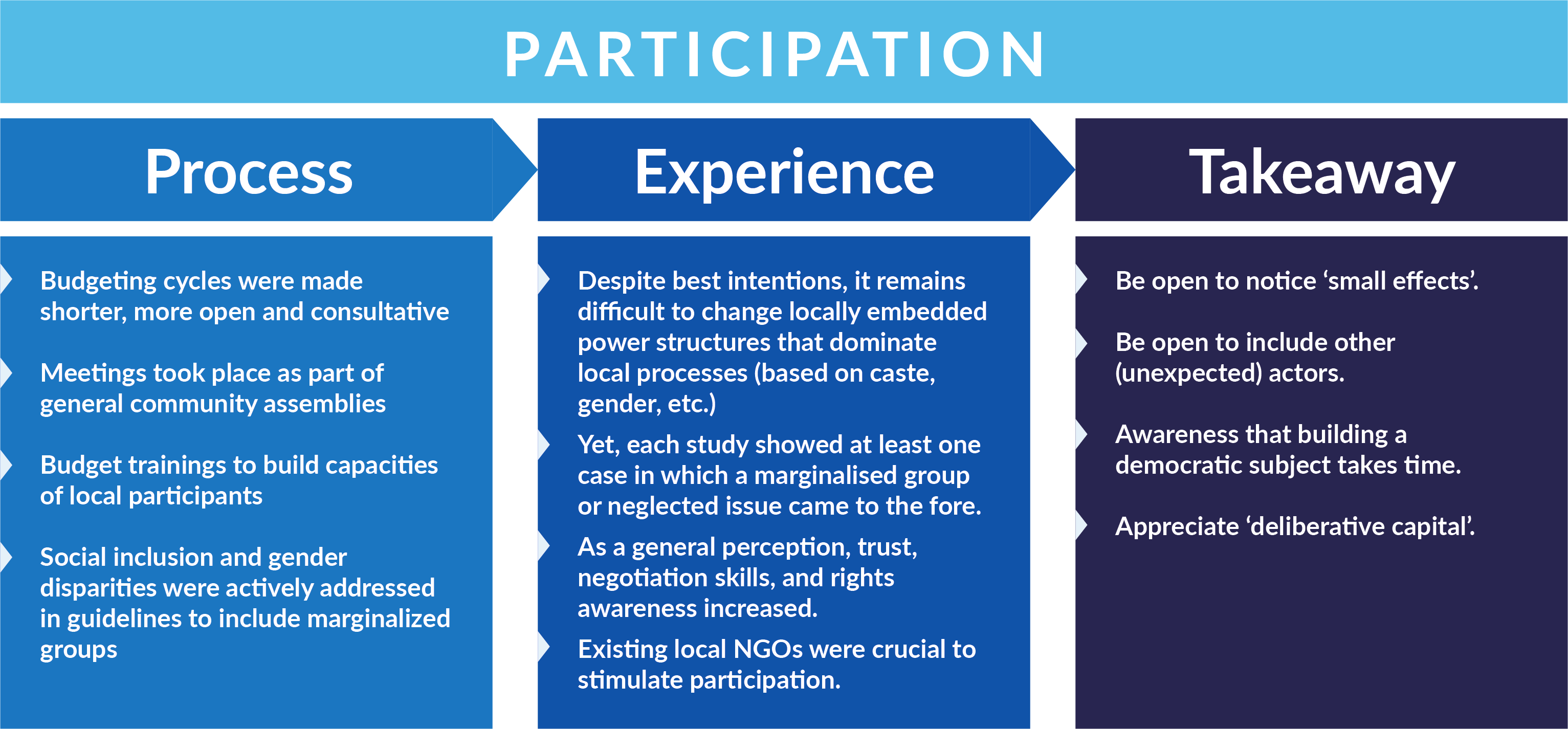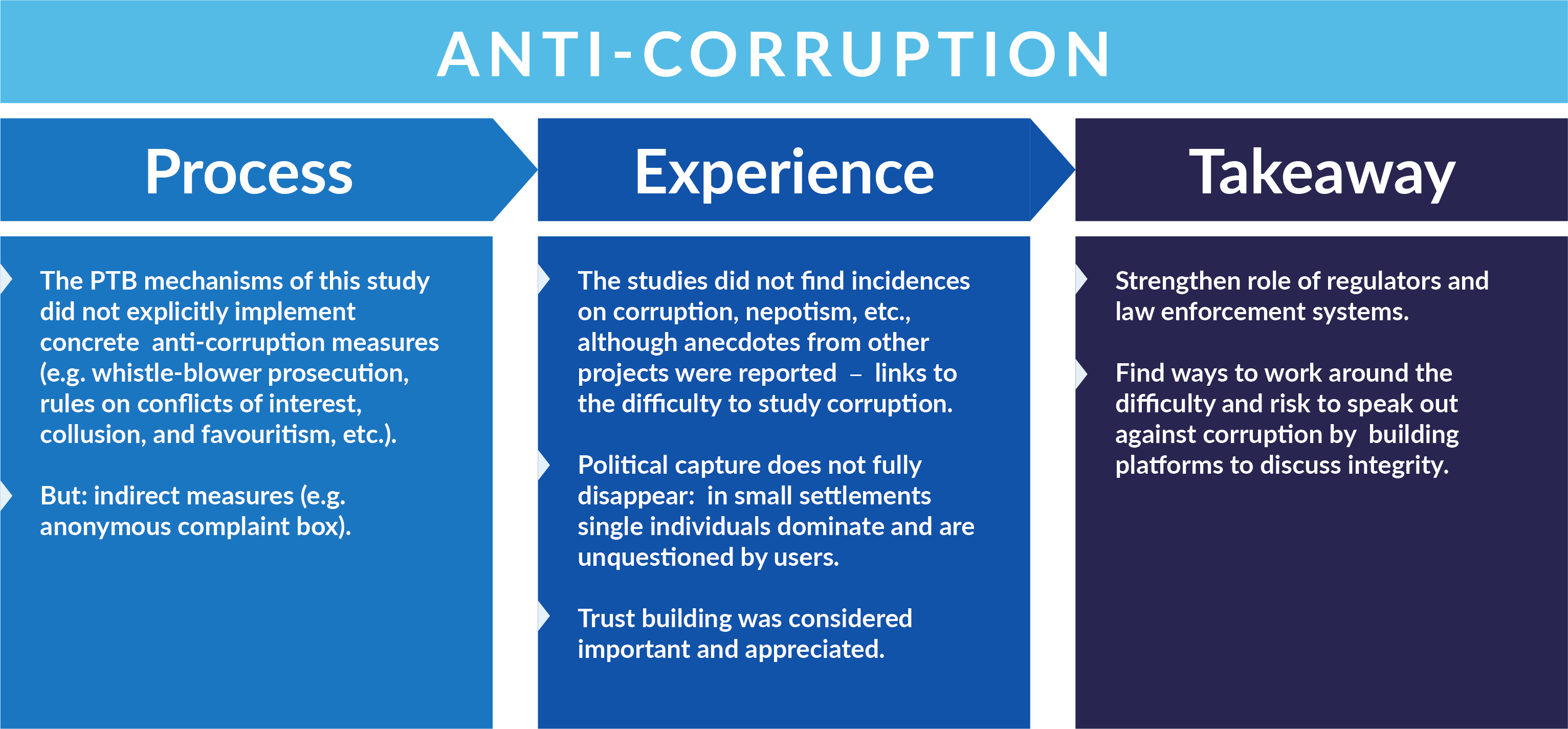Social accountability measures in the water sector have proliferated, yet there is a dearth of research on their impact on improving water integrity at the local level. This analysis discusses two qualitative case studies of participant and transparent budgeting measures (PTB) in relation to their effects on transparency, accountability, participation, and anti-corruption (TAPA). The studies find that the success of these measures is highly dependent on a favourable context due to the resilience of local power dynamics, and mismatches between the scope of the measures and user expectations which proved to be significant obstacles. The case studies therefore illustrate that the relationship between transparency, accountability, participation, and anti-corruption is complex and non-linear.
The cases indicate that PTB measures open up new spaces for deliberation and create opportunities for citizen collaboration, raising awareness of rights, and supporting citizens’ will to hold service providers to account. In so doing, PTB measures fill the gap created by weak institutions or, in more authoritarian settings, they may carve out a space for greater citizen participation in governance. As a result, donors should recognise and appreciate the development of deliberative capacities and trust building as a major goal in itself and as an important precondition to strengthen the links between TAPA. Building such a culture of accountability takes time and is not always a linear process.
In the first case study from Nepal, two communities followed a three-step participatory budgeting process (public review, public hearing and public audit) for the development of a water scheme as part of the nationwide WUMP programme coordinated by the Swiss development NGO Helvetas. The case is one where an international development organisation drives the PTB mechanism as a long-term project and local NGOs implement it. Government authorities play a limited role.
The Ethiopian case focuses on two communities that implemented a participatory budget monitoring strategy for a water scheme development as part of the Community Managed Project approach (CMP). Even though this programme was not directly related to a nationwide programme launched in 2012 to strengthen citizen action in service provision, the case is interesting, as it operates in an environment that formally endorses social accountability.
This study analyses both case studies using the Integrity Wall of the Water Integrity Network as a tool.014dd6267b74 ‘Water integrity’ is a term that broadly refers todecision-making that is fair and inclusive, honest and transparent, accountable and free of corruption.4cdc7a308737 More specifically, one can evaluate water integrity by assessing the role and strength of transparency, accountability, participation, and anti-corruption (TAPA).
Maximising transparency in budgeting measures
‘Transparency’ refers to an open flow of information and is necessary for water integrity. As it applies to participatory and transparent budgeting, transparent practice presumes that all accounts, intentions, project members, and steps of the budget cycle are openly published, accessible, timely, and reliable. In both case studies, all contract documents, expenditures, overviews of the amounts that different stakeholders contribute, and O&M manuals were accessible to everyone. Each programme took specific measures to ensure that this information was not only available, but also comprehensible to the different users. Generally, users ended up with greater knowledge about the scheme than they had had before. However, there were also some challenges: despite capacity training, a lack of technical knowledge made it difficult to meet some demands articulated at the public meetings. Moreover, illiterate stakeholders had less interest in engaging in the financial processes, and stakeholders (literate and literate) engaged less when they thought that the scheme did not correspond to their needs. Participation thus depends in part on comprehension of the published information: if local users do not understand the information or do not find the scheme relevant for their needs, they are less likely to engage with it.

Establishing accountability mechanisms within water management schemes
Accountability is a further indicator for water integrity. In order to hold actors responsible for their actions, the roles, responsibilities, and relationships between all actors must be clear, transparent, and functional. The case studies demonstrated that all PTB measures provided manuals and capacity training workshops to define and clarify roles and responsibilities. Crucial decisions were made with the knowledge of the community. Respondents stated that these mechanisms made rules for good management much clearer. Many saw such clarification as an important step for avoiding mismanagement or misappropriation of funds. Moreover, many respondents appreciated that the participatory budget meetings provided space to discuss other issues that went beyond the scheduled topics of discussion.
However, there were also challenges: capacity training for oversight groups took longer than expected, and, in one case, high turnover in the committee slowed down the overall process. It is therefore crucial that lines of accountability are clear and institutionalised and that they align with the expectations and culture of the community. This requires some negotiation and takes time.

Optimising participation in water management schemes
In both Nepal and Ethiopia, the programmes shortened budget cycles and made them more open and more consultative to ensure that as many people as possible participated. They scheduled meetings as part of general community assemblies, which the stakeholders very much appreciated. The guidelines included quotas for the participation of women and other marginalised groups. However, not all of these efforts turned out as desired. In one case the committee chairperson spoke almost exclusively during the public audit, rendering most of the participants, mere spectators. In another case, women’s participation did not improve, despite the inclusive guidelines.This shows that it is still difficult to change locally embedded power structures that often dominate such local processes (based on caste, gender, etc). Nevertheless, each study also highlighted at least one case in which a marginalised group or neglected issue came to the fore as part of the process. So overall, the process developed a space that allowed for the development of trust, negotiation skills, and also an increased awareness of the rights of all stakeholders.

Assessing anti-corruption impact
The PTB measures in this study did not explicitly implement concrete anti-corruption measures, such as whistle-blower protection or rules against conflicts of interest, collusion, and favouritism, etc. However, some projects implemented indirect measures, such as an anonymous complaint and feedback boxes, which many participants used and very much appreciated. While the users did not report incidences of corruption, the studies showed that political capture remains a problem in these processes: in small communities, single individuals often dominate the discussions and cannot be questioned or challenged. This is why it is significant that the users saw trust-building as a valuable outcome of the measures.

- WIGO 2016.
- Water Integrity Network, Delft Declaration 2013.


